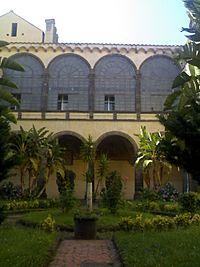Accademia degli Oziosi facts for kids

The cloister of Santa Maria delle Grazie in Naples, where the Accademia degli Oziosi originally met
|
|
| Abbreviation | Gli Oziosi (“the Idle Ones”) |
|---|---|
| Formation | 3 May 1611 |
| Founder | Giovanni Battista Manso |
| Dissolved | c. 1700 |
| Headquarters | Naples, Kingdom of Naples |
|
Official language
|
Italian |
| Remarks | Motto: Non pigra quies |
The Accademia degli Oziosi (say "Ah-kah-DEH-mee-ah dehl-yee Oh-TSEE-oh-zee") was a very famous group of writers and thinkers in Naples, Italy. They were active during the Renaissance period. Their name, "Oziosi," means "the Idle Ones," but they were actually very busy! They helped shape new ideas in poetry and literature.
Contents
History of the Academy
Founding and Early Years
The Accademia degli Oziosi was started in 1611. It was founded by Giovanni Battista Manso, who was a Marquis. The Academy officially began on May 3, 1611. Their first meetings were held in the cloister of Santa Maria delle Grazie.
This group was very important for bringing a new style of writing called "conceptismo" to Naples. Conceptismo focused on clever ideas and witty language. Before this, poetry in Naples was more traditional. The Academy quickly became a place where smart people in Naples could learn and grow.
Important Leaders and Members
When Giambattista Marino, a famous poet, came back to Naples in 1624, he was chosen as the Academy's leader, called the Principe. After Marino passed away in 1625, Manso himself became the Principe. He led the Oziosi until his own death in 1645.
The Academy first met at Santa Maria delle Grazie e Sant'Agnello. From 1615 onwards, their meetings were held at San Domenico Maggiore. Many well-known writers were members of the Oziosi. These included Angelo Grillo, Giambattista della Porta, and Giovanni Vincenzo Imperiale. Even some foreign members joined, like the brothers Bartolomé and Lupercio Leonardo de Argensola.
Influence and Decline
The Academy received support from the viceroy of Naples, Pedro Fernández de Castro, Count of Lemos. In the early 1600s, it was the most important cultural group in Naples, besides the university. Manso even introduced the famous English poet John Milton to the Accademia degli Oziosi in 1638.
By the mid-1650s, the Academy helped many poets start their careers. These poets made the "conceptismo" style even more detailed and complex. A notable example was Giuseppe Battista. The Academy stopped meeting around the year 1700. The rules of the Oziosi are kept safe in a special book at the Biblioteca Nazionale Vittorio Emanuele III.
Notable Members
- Torquato Accetto
- Bartolomé Leonardo de Argensola
- Lupercio Leonardo de Argensola
- Giuseppe Artale
- Giambattista Basile
- Giuseppe Battista
- Maiolino Bisaccioni
- Antonio Bruni
- Julius Capaccio
- Lorenzo Crasso
- Giambattista della Porta
- Angelo Grillo
- Giovanni Vincenzo Imperiale
- Giovanni Battista Manna
- Giovanni Battista Manso (Tardo)
- Giambattista Marino
- Vincenzo Mirabella
- Antonio Muscettola
- Margherita Sarrocchi
- Camillo Tutini
See also
 In Spanish: Academia de los Ociosos para niños
In Spanish: Academia de los Ociosos para niños

